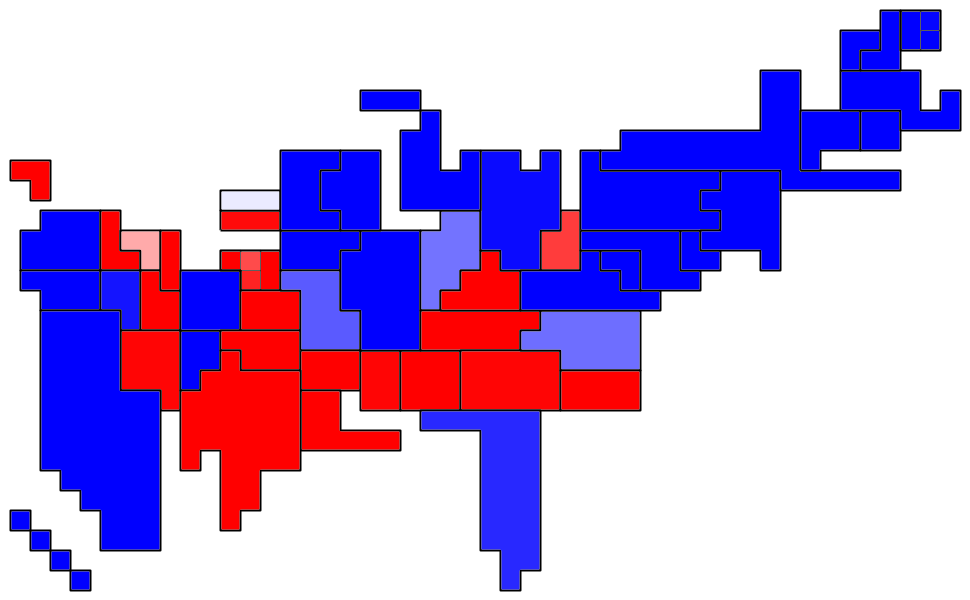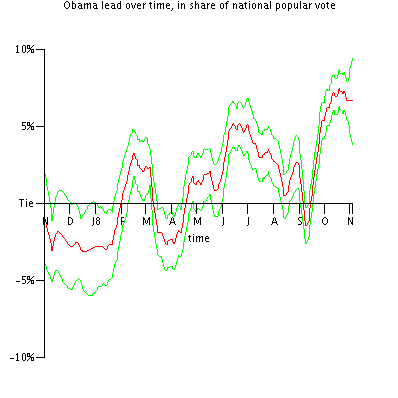Obama by 1.6%
Commentary
I've added another measure of swinginess below. The old measure is simply the correlation of a state's results to the results of the electoral college. I call the new measure a "pseudo-Banzhaf index" because it bears some relation to the Banzhaf Index. I'll explain what it is in another post this weekend, and I'll give my thoughts on the relative merits of these swinginess measure and the measure that Poblano at his excellent website.
Popular vote estimate:
(Darker red means more votes for McCain, darker green for Obama.)
Prediction if the election were today
- Probability of electoral victory: 98%.
- Expected value of electoral votes: 295.
- 95% range of electoral votes: 269 to 309.
- Probability of electoral college tie: 2%.
- Probability of popular victory: 97%.
- Expected popular vote: Win by 1.6%.
- Swing states (correlation with electoral college result):
- PA 80%
- Swing states (pseudo-Banzhaf rating):
- PA .10
- MI .02
- NM, CO, NJ .01
- Electoral vote distribution (electoral votes vs. probability):

- Confidence map (states sized by electoral vote, darker red means higher confidence that McCain will win, darker green for Obama):

Prediction for Election Day
- Probability of electoral victory: 74%.
- Expected value of electoral votes: 290.
- 95% range of electoral votes: 194 to 364.
- Probability of electoral college tie: 3%.
- Probability of popular victory: 69%.
- Expected popular vote: Win by 1.6%.
- Swing states (correlation):
- PA 89%
- OH 72%
- NH 66%
- NV 58%
- NM 57%
- MI 53%
- CO 50%
- MO 46%
- NJ 46%
- WI 40%
- Swing states (pseudo-Banzhaf):
- PA .12
- OH .04
- MI, NM .03
- CO .02
- NJ, NV, WI .01
- Electoral vote distribution (electoral votes vs. probability):

- Confidence map (states sized by electoral vote, darker red means higher confidence that McCain will win, darker green for Obama):




1 Comments:
The real issue is not how well Clinton, Obama, or McCain might do in the closely divided battleground states, but that we shouldn't have battleground states and spectator states in the first place. Every vote in every state should be politically relevant in a presidential election. And, every vote should be equal. We should have a national popular vote for President in which the White House goes to the candidate who gets the most popular votes in all 50 states.
The National Popular Vote bill would guarantee the Presidency to the candidate who receives the most popular votes in all 50 states (and DC). The bill would take effect only when enacted, in identical form, by states possessing a majority of the electoral votes—that is, enough electoral votes to elect a President (270 of 538). When the bill comes into effect, all the electoral votes from those states would be awarded to the presidential candidate who receives the most popular votes in all 50 states (and DC).
The major shortcoming of the current system of electing the President is that presidential candidates have no reason to poll, visit, advertise, organize, campaign, or worry about the voter concerns in states where they are safely ahead or hopelessly behind. The reason for this is the winner-take-all rule which awards all of a state's electoral votes to the candidate who gets the most votes in each separate state. Because of this rule, candidates concentrate their attention on a handful of closely divided "battleground" states. Two-thirds of the visits and money are focused in just six states; 88% on 9 states, and 99% of the money goes to just 16 states. Two-thirds of the states and people are merely spectators to the presidential election.
Another shortcoming of the current system is that a candidate can win the Presidency without winning the most popular votes nationwide.
The National Popular Vote bill has been approved by 17 legislative chambers (one house in Colorado, Arkansas, Maine, North Carolina, and Washington, and two houses in Maryland, Illinois, Hawaii, California, and Vermont). It has been enacted into law in Hawaii, Illinois, New Jersey, and Maryland. These states have 50 (19%) of the 270 electoral votes needed to bring the law into effect.
See http://www.NationalPopularVote.com
Post a Comment
<< Home